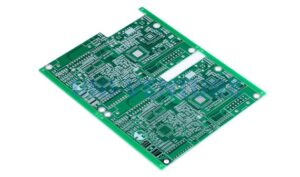As you know, the base material (polymer or glass) is changing from a glassy, solid, rigid state to a rubbery state as the temperature rises to a certain region, so the temperature at this point is called the glass transition temperature (Tg ). That is, Tg is the mechanical property that specifies the glass transition temperature, i.e., the maximum temperature at which the glass remains rigid. In other words, ordinary PCB substrates will not only soften, deform, melt, and other phenomena at high temperatures, but mechanical and electrical properties will also decline dramatically, which can affect the life of the product.
Needless to say, normal PCB FR4-Tg is 130-140 degrees, medium Tg is greater than 150-160 degrees, and high Tg is greater than 170 degrees. High FR4-Tg provides better mechanical and chemical resistance to heat and moisture compared to standard FR4. The higher the Tg value, the better the heat resistance of the material, and therefore, especially in lead-free processes, the Tg is getting higher.
High Tg PCB performance
With the rapid development of the electronics industry, high Tg materials are widely used in computers, communication devices, precision instruments, and instrumentation. In order to achieve high functionality and high multilayer development, PCB substrate materials need higher heat resistance as a prerequisite. Moreover, due to the emergence and development of high-density mounting technology represented by SMT and CMT, the substrate is increasingly inseparable from the high heat resistance of the substrate in the case of thinning, small aperture, and fine wiring. Therefore, the difference between general FR-4 and high FR4-Tg is that the mechanical strength, adhesion, water absorption, dimensional stability, thermal state (especially after water absorption) in the thermal state of thermal decomposition is the difference between different conditions (such as thermal expansion), it is obvious that high Tg PCB is better than ordinary PCB substrate material. Therefore, in recent years there has been a great demand for high Tg PCBs, but at a higher price than normal PCBs.
What’s more, high Tg materials are also popular in the LED lighting industry because LEDs have a higher hat dissipation rate than ordinary electronic components, but the same structure of FR-4 boards is much cheaper than metal-core PCBs such as aluminum-core PCBs.
Advantages of High Tg PCBs
Higher stability: If you increase the Tg of a PCB substrate, it will automatically improve heat resistance, chemical resistance, humidity resistance, and device stability.
Withstand high power density designs: If the device has a high power density and considerable heat generation, then a high Tg PCB would be a good solution for heat management.
When reducing heat generation from common boards, larger printed circuit boards can be used to change the design and power requirements of the device, and high Tg PCBs can also be used.
Ideal for multilayer and HDI PCBs: Because multilayer and HDI PCBs are more compact and circuit-dense, they will result in high levels of heat dissipation. Therefore, high Tg PCBs are typically used for multilayer and HDI PCBs to ensure reliability in PCB manufacturing.
When do I need a high Tg PCB?
Your application will require a high Tg PCB if your printed circuit board cannot withstand thermal loads of up to 25 degrees C. In addition, it ensures the safety of using high Tg PCBs if your product is operating in the 130 degree C or higher temperature range. Needless to say, the primary reason for high Tg PCBs is the move to RoHS PCBs. as a result, more and more of the PCB industry is turning to high Tg materials because of the higher temperatures required for lead-free solder to flow.
Applications
If the power density in the electronics is higher and the heat generation will interfere with the heat sink or other parts of the product, then high Tg PCBs are the best solution. In addition, with the popularity of high Tg PCBs in recent years, you will find Tg PCBs being used in electronics industries that can operate at higher temperatures. Therefore, we meet the needs of customers in different industries by offering high Tg PCBs with high heat resistance that can meet customer specifications in a short lead time. Therefore, they are some application examples as follows:
Gateways, RFID, inverters, antenna boards, wireless boosters, contract manufacturing services, low-cost PLCs, embedded system development, embedded computer systems, AC power supplies.
For a specification of what we can make, check the following:
Number of layers: 1-14 layers
PCB size: min 10 * 15mm, max 500 * 600mm
Finished board thickness: 0.2-3.5mm
Copper weight: 1 / 3oz-4oz
Finish: HASL with lead / HASL without lead / immersion gold / immersion silver / immersion tin / OSP – Organic Solderability Preservative – RoHS
Solder Resist Film: green/ red/ yellow/ blue/ white/ black/ purple/ matte black/ matte green
Silkscreen: white/black
Minimum line width/spacing: 3 / 3 mil
Minimum hole size: 0.1mm
Quality class: Standard IPC II















